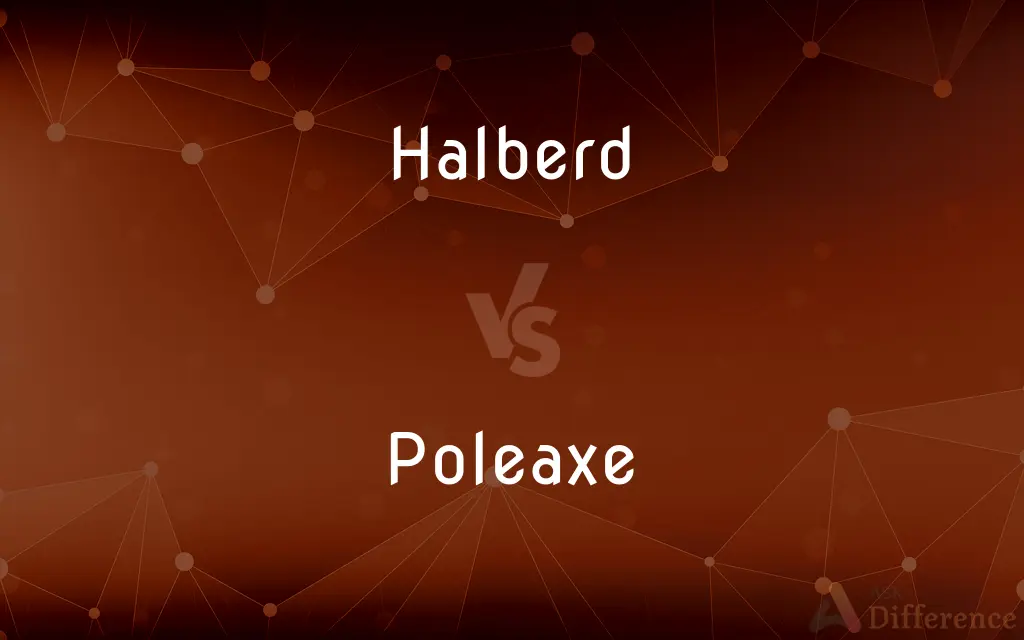Halberd vs. Poleaxe — What's the Difference?
By Urooj Arif & Fiza Rafique — Updated on March 11, 2024
Halberds are versatile pole weapons combining an axe blade with a spear tip and a hook, while poleaxes, often heavier, are designed for armor penetration.

Difference Between Halberd and Poleaxe
Table of Contents
ADVERTISEMENT
Key Differences
Halberds, originating in the 14th century, were a blend of a spear and an axe, equipped with a spike at the top for thrusting and a hook for pulling cavalry off horses. Poleaxes, on the other hand, evolved primarily for use in armored combat, often among knights and heavy infantry.
While both weapons share the characteristic of being pole arms, their specific features and intended uses highlight the differences in medieval warfare tactics. Halberds were more common among general infantry for their utility and ease of use, whereas poleaxes were preferred by soldiers or knights engaging in close combat or duels, where armor penetration was crucial.
The halberd's design facilitated actions such as hooking and pulling, slashing, and thrusting, making it a versatile weapon on the battlefield. In contrast, the poleaxe's construction, with its heavier head and combination of hammer, axe, and spike, was optimized for breaching armor.
Despite their differences, both the halberd and the poleaxe reflect the adaptability of medieval weaponry to the changing demands of warfare, from open field battles to the close quarters of siege warfare. The evolution of these weapons over time underscores the ongoing arms race between offensive and defensive technologies in historical combat.
Comparison Chart
Origin
14th century
Medieval period, precise origins vary
ADVERTISEMENT
Primary Use
Versatile; used against both infantry and cavalry
Armor penetration in close combat
Design Elements
Axe blade, spear tip, and hook
Axe blade, hammerhead, and spike
Weight
Lighter, for swift movements
Heavier, for powerful blows
Preferred by
General infantry
Knights and heavy infantry
Compare with Definitions
Halberd
Used for slashing, thrusting, and hooking opponents.
With his halberd, he hooked the enemy's shield, pulling it aside.
Poleaxe
A heavy pole weapon designed for armor penetration, featuring a hammer, axe, and spike.
The knight grasped his poleaxe, ready to breach the opponent's armor.
Halberd
Characterized by a long pole with a multifunctional head.
The halberd's long pole kept the enemy at a distance.
Poleaxe
Optimized for close combat and defeating armored opponents.
The poleaxe was invaluable in sieges, where close combat was frequent.
Halberd
Popular among medieval infantry for its versatility.
Medieval infantry formations often included soldiers armed with halberds.
Poleaxe
Primarily used for delivering powerful blows to penetrate armor.
He swung his poleaxe with great force, aiming at the joints in the armor.
Halberd
A pole weapon combining an axe blade with a spear tip and a hook.
The soldier wielded a halberd, its axe blade glinting in the sunlight.
Poleaxe
Includes a heavy head with multiple combat features.
The poleaxe's heavy head was capable of delivering crushing blows.
Halberd
Effective against both foot soldiers and cavalry.
The halberd proved effective at piercing through the cavalry's defenses.
Poleaxe
Favored by knights and heavy infantry in close combat.
In duels, knights often preferred the poleaxe for its effectiveness against armor.
Halberd
A halberd (also called halbard, halbert or Swiss voulge) is a two-handed pole weapon that came to prominent use during the 14th, 15th, and 16th centuries. The word halberd is most likely equivalent to the German word Hellebarde, deriving from Middle High German halm (handle) and barte (battleaxe) joined to form helmbarte.
Poleaxe
The poleaxe (also pollaxe, pole-axe, pole axe, poleax, polax) is a European polearm that was widely used by medieval infantry.
Halberd
A combined spear and battleaxe.
Poleaxe
Another term for battleaxe (sense 1)
Halberd
A weapon of the 1400s and 1500s having an axelike blade and a steel spike mounted on the end of a long shaft.
Poleaxe
An axe having a hammer face opposite the blade, used to slaughter cattle.
Halberd
A two-handed pole weapon, consisting of a long pole with an axe-like blade mounted on it (at a right angle like an axe, not on the tip like a spear), and (opposite the blade) typically a spike or hook.
Poleaxe
A medieval battle-axe consisting of a long shaft ending in an axe or a combination of an axe, hammer, and pick.
Halberd
An ancient long-handled weapon, of which the head had a point and several long, sharp edges, curved or straight, and sometimes additional points. The heads were sometimes of very elaborate form.
Poleaxe
To strike or fell with or as if with a poleaxe
"When a gang of doves circled above the flowing water and swooped in to feed, he poleaxed the leader with a clean head shot" (William Hoffman).
Halberd
A pike fitted with an ax head
Poleaxe
An ax having both a blade and a hammer face; used to slaughter cattle.
Poleaxe
(historical) A long-handled battle axe, being a combination of ax, hammer and pike.
Poleaxe
(transitive) To fell someone with, or as if with, a poleaxe.
Poleaxe
To astonish; to shock or surprise utterly.
Poleaxe
To stymie, thwart, cripple, paralyze.
Poleaxe
An ax used to slaughter cattle; has a hammer opposite the blade
Poleaxe
A battle ax used in the Middle Ages; a long handled ax and a pick
Poleaxe
Fell with or as if with a poleax
Common Curiosities
Did halberds evolve from poleaxes or vice versa?
The halberd and poleaxe evolved separately to meet different battlefield needs.
Can a poleaxe be used effectively against unarmored opponents?
Yes, but it is specifically designed for combat against armored foes.
Are halberds still used today?
No, they are obsolete in modern warfare but may be found in ceremonial contexts.
Were these weapons used in any famous historical battles?
Both were used in numerous medieval battles across Europe.
What is the main difference between a halberd and a poleaxe?
The halberd is a versatile weapon combining an axe, spear, and hook, designed for general infantry, while the poleaxe is heavier, optimized for armor penetration and preferred by knights.
Were halberds used by cavalry?
No, halberds were primarily infantry weapons, though they were effective against cavalry.
How long were typical halberds and poleaxes?
Lengths varied, but halberds often ranged from 5 to 6 feet, while poleaxes were shorter.
Did soldiers need special training to use these weapons?
Yes, effective use required training in specific techniques and strategies.
Was the poleaxe only a European weapon?
While most associated with Europe, similar concepts existed in other cultures.
How were halberds and poleaxes manufactured?
Both required skilled blacksmiths for their complex heads and sturdy poles.
Were halberds and poleaxes used in naval combat?
Halberds were sometimes used aboard ships, but poleaxes were less common in naval contexts.
How are halberds and poleaxes viewed in historical reenactments today?
They are popular in reenactments for their historical significance and the techniques required for their use.
How did the introduction of firearms affect the use of halberds and poleaxes?
The rise of firearms gradually made these pole weapons obsolete on the battlefield.
Did the design of halberds and poleaxes vary by region?
Yes, designs could vary significantly based on regional preferences and technological advancements.
Could a halberd or poleaxe pierce plate armor?
While difficult, the spike of a halberd or the hammer and spike of a poleaxe could exploit weaknesses in armor.
Share Your Discovery

Previous Comparison
Declamation vs. Monologue
Next Comparison
Lord vs. KingAuthor Spotlight
Written by
Urooj ArifUrooj is a skilled content writer at Ask Difference, known for her exceptional ability to simplify complex topics into engaging and informative content. With a passion for research and a flair for clear, concise writing, she consistently delivers articles that resonate with our diverse audience.
Co-written by
Fiza RafiqueFiza Rafique is a skilled content writer at AskDifference.com, where she meticulously refines and enhances written pieces. Drawing from her vast editorial expertise, Fiza ensures clarity, accuracy, and precision in every article. Passionate about language, she continually seeks to elevate the quality of content for readers worldwide.














































